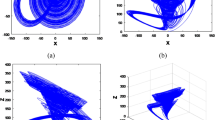Abstract
Information security has become a significant issue in encryption due to the rapid progress of internet and network. Therefore, the development of the encryption algorithm is a growing and significant problem. In this study, a new color image encryption was introduced based on DNA complementary rules and pair coupled chaotic maps. At first, the plain color image was divided into three components (R, G, B) being converted into three DNA matrices using DNA encoding rules. Secondly, DNA addition for R, G and B components was implemented and scrambled the elements position of three DNA sequence via the pair coupled chaotic maps. Three gray coded images obtained and RGB encrypted image was achieved by restructuring R, G, B components. The simulation of experimental result and security analysis showed that this algorithm had larger secret key space and strong secret key sensitivity and it had excellent ability to resist against statistical and differential attacks.








Similar content being viewed by others
References
Adleman LM (1994) Molecular computation of solutions of combinatiorial problems. Science 266:1021–1024
Ahadpour S, Behnia S, Jafarizadeh MA (2009) Synchronization in pair-coupled maps with invariant measure. Commun Nonlinear Sci Numer Simulat 14:2916–2922
Ahadpour S, Sadra Y (2012) Randomness criteria in binary visibility graph and complex network perspective. J Inf Sci 197:161–176
Ahadpour S, Majidpour M (2013) Image steganography using discrete cross-coupled chaotic maps. Watam Press Dynamics of Continuous. Discrete and Impulsive Systems Series B: Applications Algorithms 20:283–292
Akhavan A, Samsudin A, Akhshani A (2017) Cryptanalysis of an image encryption algorithm based on DNA encoding. Opt Laser Technol 95:94–99
Alvarez G, Li S (2006) Some basic cryptographic requirements for chaos-based cryptosystems. Int J Bifurcation Chaos 16:2129–2151
Amani H, Yaghoobi M (2019) A new approach in adaptive encryption algorithm for color images based on DNA sequence operation and hyper-chaotic system. Multimed Tools Appl 78:21537–21556
Babaei M (2013) A novel text and image encryption method based on chaos theory and DNA computing. Natural Comput 12:101–107
Behnia S, Akhshani A, Ahadpour S (2011) An analytical invariant measure for random maps with position dependent. Dynamics of Continuous, Discrete and Impulsive Systems Series A: Mathematical Analysis 18:245–255
Behnia S, Akhshani A, Ahadpour S, Mahmodi H, Akhavan A (2007) A fast chaotic encryption scheme based on piecewise nonlinear chaotic maps. Phys Lett A 366:391–396
Belazi A, Abd AA, El-Latif SB (2016) A novel image encryption scheme based on substitution-permutation network and chaos. Signal Procss 128:155–170
Chai X, Chen Y, Broyde L (2017) A novel chaos-based image encryption algorithm using DNA sequence operations. Opt Lasers Eng 88:197–213
Chai XL, Yang K, Gan ZH (2017) A new chaos-based image encryption algorithm with dynamic key selection mechanisms. Multimed Tools Appl 76:9907–9927
Chen J, Zhu Z, Zhang L, Zhang Y, Yang B (2018) Exploiting self-adaptive permutation-diffusion and DNA random encoding for secure and efficient image encryption. Signal Process 142:340–353
Gan Z, Chai X, Yuan K, Lu Y (2018) A novel image encryption algorithm based on LFT based S-boxes and chaos. Multimed Tools Appl 77:8759–8783
Guesmi R, Farah MAB, Kachouri A, Samet M (2016) A novel chaos-based image encryption using DNA sequence operation and Secure Hash Algorithm SHA-2. Nonlinear Dyn 83:1123–1136
Hu T, Liu Y, Gong L, Guo S, Yuan H (2017) Chaotic image cryptosystem using DNA deletion and DNA insertion. Signal Process 134:234–243
Jafarizadeh A, Behnia S, Khorram S, Nagshara H (2001) Hierarchy of chaotic maps with an invariant measure. J Statistical Phys 104:1013–1028
Liu H, Wang X, Kadir A (2012) Image encryption using DNA complementary rule and chaotic maps. Appl Soft Comput 12:1457–1466
Liu L, Zhang Q, Wei X (2012) A RGB image encryption algorithm based on DNA encoding and chaos map. Comput Electr Eng 38:1240–1248
Norouzi B, Seyedzadeh SM, Kuchaki SM, Mosavi MR (2014) A novel image encryption based on hash function with only two-round diffiusion process. J Multimed Syst 20:45–64
Rehman A, et al. (2018) An efficient mixed inter-intra pixels substitution at 2bits-level for image encryption technique using DNA and chaos. Optik 153:117–134
Rehman A, Liao X (2019) A novel robust dual diffusion/confusion encryption technique for color image based on Chaos, DNA and SHA-2. Multimed Tools Appl 78:2105–2133
Rehman A, Liao X, Ashraf R, Ullah S, Wang H (2018) A color image encryption technique using exclusive- OR with DNA complementary rules based on Chaos theory and SHA-2. Optik 159:348–367
Wang X, Teng L, Xue Q (2012) A novel colour image encryption algorithm based on chaos. Signal Process 92:1101–1108
Wang X, Li P, Qian Y, Liu L, Zhang H, Wang X (2018) A novel color image encryption scheme using DNA permutation based on the Lorenz system. Multimed Tools Appl 77:6243–6265
Watson JD, Crick FHC (1953) Molecular structure of nucleic acids: a structure for deoxyribose nucleic acid. Nature 171:737–738
Wu X, Kan H, Kurths J (2015) A new color image encryption scheme based on DNA sequences and multiple improved 1D chaotic maps. Appl Soft Comput 37:24–39
Yaghouti Niyat A, Moattar MH, Niazi Torshiz M (2017) Color image encryption based on hybrid hyper-chaotic system and cellular automata. Opt Lasers Eng 90:225–237
Zeng L, Liu R (2015) Cryptanalyzing a novel couple images encryption algorithm based on DNA subsequence operation and chaoticsystem. Optik 126:5022–5025
Zhang Y, Li Y, Wen W, Wu Y, Chen J (2015) Deciphering an image cipher based on 3-cell chaotic map and biological operations. Nonlinear Dyn 82:1831–1837
Zhen P, Zhao G, Min L, Jin X (2016) Chaos-based image encryption scheme combining DNA coding and entropy. Multimed Tools Appl 75:6303–6319
Author information
Authors and Affiliations
Corresponding author
Additional information
Publisher’s note
Springer Nature remains neutral with regard to jurisdictional claims in published maps and institutional affiliations.
Rights and permissions
About this article
Cite this article
Azimi, Z., Ahadpour, S. Color image encryption based on DNA encoding and pair coupled chaotic maps. Multimed Tools Appl 79, 1727–1744 (2020). https://doi.org/10.1007/s11042-019-08375-6
Received:
Revised:
Accepted:
Published:
Issue Date:
DOI: https://doi.org/10.1007/s11042-019-08375-6




